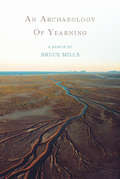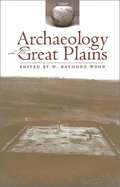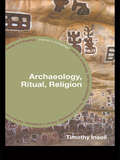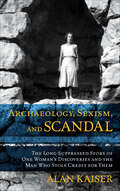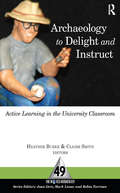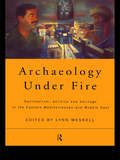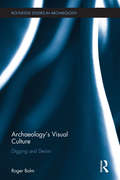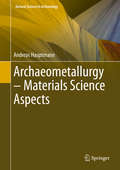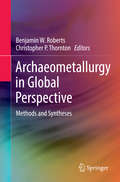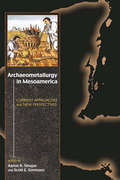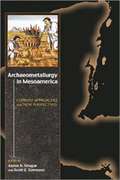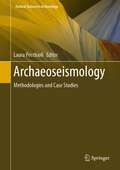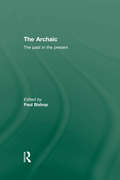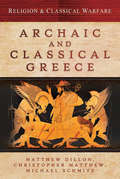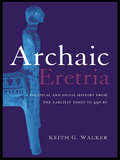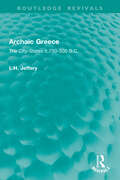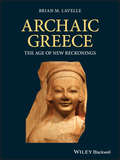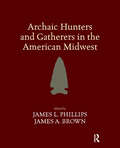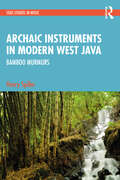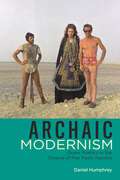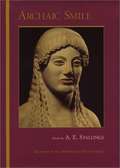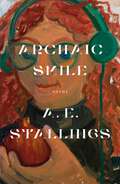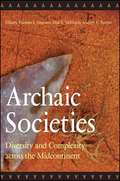- Table View
- List View
An Archaeology of Yearning
by Bruce MillsDigging into vivid moments within the metaphor of archaeology, Bruce Mill's remarkable memoir maps the artifacts of life as a father of a boy with autism, and as a boy himself growing up in rural Iowa. An Archaeology of Yearning is not ultimately about autism; instead it reaches into the world of human connection and illuminates how storytelling and an understanding of language keep that connection alive.On some nights, I awake as if in a cave and think of the future. Mary and I will exist as memories: a quick glimpse of arms reaching toward another's shoulders or face, an image of a hand upon a book, the scent of our bodies after the sweat of sleep, the tone of our young and old voices calling our daughter or son from distant rooms or down a stair.Eventually I arrive on the image of my son, in some new home. No matter how much I have written or catalogued or kept in images, I know that the site of his life and mine will inevitably remain fragments and that only a visitor can bring us to life.Bruce Mills has published scholarly books and articles on nineteenth-century American writings and co-edited a collection of essays by siblings of those on the autism spectrum. His creative nonfiction has appeared in The Georgia Review and New England Review. He teaches in the English Department at Kalamazoo College.
Archaeology on the Great Plains
by W. Raymond WoodThis book provides a descriptive culture history of human groups on the Great Plains, focusing on that environmental and cultural diversity and on the changing archaeological record." Did you know that the Plains Indians used a complicated sign language as the language of trade, and that they traded with peoples far and near?
Archaeology, Ritual, Religion (Themes in Archaeology Series)
by Timothy InsollThe archaeology of religion is a much neglected area, yet religious sites and artefacts constitute a major area of archaeological evidence. Timothy Insoll presents an introductory statement on the archaeology of religion, examining what archaeology can tell us about religion, the problems of defining and theorizing religion in archaeology, and the methodology, or how to 'do', the archaeology of religion.This volume assesses religion and ritual through a range of examples from around the world and across time, including prehistoric religions, shamanism, African religions, death, landscape and even food. Insoll also discusses the history of research and varying theories in this field before looking to future research directions. This book will be a valuable guide for students and archaeologists, and initiate a major area of debate.
Archaeology, Sexism, and Scandal: The Long-Suppressed Story of One Woman's Discoveries and the Man Who Stole Credit for Them
by Alan KaiserA true story of plagiarism, complicity, and a 1930s excavation that &“has the arresting immediacy of investigative journalism&” (The Journal of Hellenic Studies). The 1931 excavation season at Olynthus, Greece, ushered a sea change in how archaeologists study material culture—and was the nexus of one of the most egregious (and underreported) cases of plagiarism in the history of classical archaeology. In this book, Alan Kaiser draws on the private scrapbook that budding archaeologist Mary Ross Ellingson compiled during that dig, as well as her personal correspondence and materials from major university archives, to paint a fascinating picture of gender, power, and archaeology in the early twentieth century. Using Ellingson&’s photographs and letters as a guide, Kaiser brings alive the excavations led by David Robinson and recounts how the unearthing of private homes—rather than public spaces—emerged as a means to examine the day-to-day of ancient life in Greece. But as Archaeology, Sexism, and Scandal clearly demonstrates, a darker story lurks beneath the smiling faces and humorous tales: one in which Robinson stole Ellingson&’s words and insights for his own, and fellow academics looked the other way—denying her the credit she was due for more than eighty years. &“Kaiser&’s exciting and timely volume should force readers to openly confront gender-related biases in science and academia.&” —Library Journal (starred review) &“Important.&” —Publishers Weekly &“Highly recommended.&” —Choic
Archaeology to Delight and Instruct: Active Learning in the University Classroom (One World Archaeology Ser. #49)
by Heather Burke Claire SmithThis book presents novel and interesting ways of teaching archaeological concepts and processes to college and university students. Seeking alternatives to the formal lecture format, the various contributions seek better ways of communicating the complexities of human behavior and of engaging students in active learning about the past. This collection of imaginative exercises designed by 20 master instructors on three continents includes role-playing, games, simulations, activities, and performance, all designed to teach archaeological concepts in interesting and engaging ways.
Archaeology Under Fire: Nationalism, Politics and Heritage in the Eastern Mediterranean and Middle East
by Lynn MeskellFirst published in 1998. Routledge is an imprint of Taylor & Francis, an informa company.
Archaeology's Visual Culture: Digging and Desire (Routledge Studies in Archaeology)
by Roger BalmArchaeology’s Visual Culture explores archaeology through the lens of visual culture theory. The insistent visuality of archaeology is a key stimulus for the imaginative and creative interpretation of our encounters with the past. Balm investigates the nature of this projection of the visual, revealing an embedded subjectivity in the imagery of archaeology and acknowledging the multiplicity of meanings that cohere around artifacts, archaeological sites and museum displays. Using a wide range of case studies, the book highlights how archaeologists can view objects and the consequences that ensue from these ways of seeing. Throughout the book Balm considers the potential for documentary images and visual material held in archives to perform cultural work within and between groups of specialists. With primary sources ranging from the mid-nineteenth to the early twenty-first century, this volume also maps the intellectual and social connections between archaeologists and their peers. Geographical settings include Britain, Cyprus, Mesoamerica, the Middle East and the United States, and the sites of visual encounter are no less diverse, ranging from excavation reports in salvage archaeology to instrumentally derived data-sets and remote-sensing imagery. By forensically examining selected visual records from published accounts and archival sources, enduring tropes of representation become apparent that transcend issues of style and reflect fundamental visual sensibilities within the discipline of archaeology.
Archaeometallurgy – Materials Science Aspects (Natural Science in Archaeology)
by Andreas HauptmannThis book successfully connects archaeology and archaeometallurgy with geoscience and metallurgy. It addresses topics concerning ore deposits, archaeological field evidence of early metal production, and basic chemical-physical principles, as well as experimental ethnographic works on a low handicraft base and artisanal metal production to help readers better understand what happened in antiquity. The book is chiefly intended for scholars and students engaged in interdisciplinary work.
Archaeometallurgy in Global Perspective: Methods and Syntheses
by Benjamin W. Roberts Christopher P. ThorntonThe study of ancient metals in their social and cultural contexts has been a topic of considerable interest in archaeology and ancient history for decades, partly due to the modern dependence on technology and man-made materials. The formal study of Archaeometallurgy began in the 1970s-1980s, and has seen a recent growth in techniques, data, and theoretical movements. This comprehensive sourcebook on Archaeometallurgy provides an overview of earlier research as well as a review of modern techniques, written in an approachable way. Covering an extensive range of archaeological time-periods and regions, this volume will be a valuable resource for those studying archaeology worldwide. It provides a clear, straightforward look at the available methodologies, including: * Smelting processes * Slag analysis * Technical Ceramics * Archaeology of Mining and Field Survey * Ethnoarchaeology * Chemical Analysis and Provenance Studies * Conservation Studies With chapters focused on most geographic regions of Archaeometallurgical inquiry, researchers will find practical applications for metallurgical techniques in any area of their study. Ben Roberts is a specialist in the early metallurgy and later prehistoric archaeology of Europe. He was the Curator of the European Copper and Bronze Age collections at the British Museum between 2007 and 2012 and is now a Lecturer in Prehistoric Europe in the Departm ent of Archaeology at the Durham University, UK. Chris Thornton is a specialist in the ancient metallurgy of the Middle East, combining anthropological theory with archaeometrical analysis to understand the development and diffusion of metallurgical technologies throughout Eurasia. He is currently a Consulting Scholar of the University of Pennsylvania Museum, where he received his PhD in 2009, and the Lead Program Officer of research grants at the National Geographic Society.
Archaeometallurgy in Mesoamerica: Current Approaches and New Perspectives
by Aaron N. Shugar Scott E. SimmonsPresenting the latest in archaeometallurgical research in a Mesoamerican context, Archaeometallurgy in Mesoamerica brings together up-to-date research from the most notable scholars in the field. These contributors analyze data from a variety of sites, examining current approaches to the study of archaeometallurgy in the region as well as new perspectives on the significance metallurgy and metal objects had in the lives of its ancient peoples. The chapters are organized following the cyclical nature of metals--beginning with extracting and mining ore, moving to smelting and casting of finished objects, and ending with recycling and deterioration back to the original state once the object is no longer in use. Data obtained from archaeological investigations, ethnohistoric sources, ethnographic studies, along with materials science analyses, are brought to bear on questions related to the integration of metallurgy into local and regional economies, the sacred connotations of copper objects, metallurgy as specialized crafting, and the nature of mining, alloy technology, and metal fabrication.
Archaeometallurgy in Mesoamerica
by Aaron N. Shugar Scott E. SimmonsPresenting the latest in archaeometallurgical research in a Mesoamerican context,Archaeometallurgy in Mesoamericabrings together up-to-date research from the most notable scholars in the field. These contributors analyze data from a variety of sites, examining current approaches to the study of archaeometallurgy in the region as well as new perspectives on the significance metallurgy and metal objects had in the lives of its ancient peoples. The chapters are organized following the cyclical nature of metals--beginning with extracting and mining ore, moving to smelting and casting of finished objects, and ending with recycling and deterioration back to the original state once the object is no longer in use. Data obtained from archaeological investigations, ethnohistoric sources, ethnographic studies, along with materials science analyses, are brought to bear on questions related to the integration of metallurgy into local and regional economies, the sacred connotations of copper objects, metallurgy as specialized crafting, and the nature of mining, alloy technology, and metal fabrication.
Archaeoseismology: Methodologies and Case Studies (Natural Science in Archaeology)
by Laura PecchioliArchaeoseismic research provides data and information on past earthquakes but is limited by the lack of ongoing discussions about methodology. This volume is an interdisciplinary approach including archaeologists, geologists, geophysicists, seismologists, engineers, and architects from different countries to present a comprehensive recording and interpretation of ancient natural disasters on some case studies. The publication is an introduction to various aspects of the field of archaeoseismology for the knowledge of past seismicity, the reconstruction of the chronological history of a place, the interpretation and identification of seismic effects using different methods, etc. The collection provides an overview of research into archaeoseismology, making new contributions through innovative ideas on various topics. The publication can be an illustrative introduction to better understand the complexity of interpreting seismic effects on ancient and modern masonries, particularly for students with an open mind.
The Archaic: The Past in the Present
by Paul BishopThe Archaic takes as its major reference points C.G. Jung's classic essay, 'Archaic Man' (1930), and Ernesto Grassi's paper on 'Archaic Theories of History' (1990). Moving beyond the confines of a Jungian framework to include other methodological approaches, this book explores the concept of the archaic. Defined as meaning 'old-fashioned', 'primitive', 'antiquated', the archaic is, in fact, much more than something very, very old: it is timeless, inasmuch as it is before time itself. Archē, Urgrund, Ungrund, 'primordial darkness', 'eternal nothing' are names for something essentially nameless, yet whose presence we nevertheless intuit. This book focuses on the reception of myth in the tradition of German Idealism or Romanticism (Creuzer, Schelling, Nietzsche), which not only looked back to earlier thinkers (such as Jacob Boehme) but also laid down roots for developments in twentieth-century thought (Ludwig Klages, Martin Heidegger). The Archaic also includes: studies of the Germanic dimension of the archaic (Charles Bambach, Alan Cardew) a discussion of the mytho-phenomenological approach to the archaic (Robert Josef Kozljanič) a series of articles on Jung's understanding of the archaic (Paul Bishop, Susan Rowland, Robert Segal). This book will be of interest to psychoanalysts, anthropologists and phenomenologists, as well as students of psychology, cultural studies, religious studies, and philosophy, as it seeks to rehabilitate a concept of demonstrable and urgent relevance for our time.
Archaic and Classical Greece
by Michael H. Crawford David WhiteheadThe aim of this book is to collect in one comprehensive volume a representative selection of ancient sources in translation, with commentary, on the history, institutions, society and economy of the Greek world from c. 750 to 338 BC - that is, the period best known and most important for the evolution of the polis, a form of political community which combined the aspects of city and state in a physical and psychological unity unparalleled either before or since. For us, the inheritors of much that the Greeks created, there is an inherent interest in the way in which they organised their society during these centuries. Although this book assumes no knowledge of Greek, the reader is introduced to a range of key Greek words and concepts which offer a direct insight into the mentality, both collective and individual, of the times. The sources themselves (all of which have been translated by the authors) are supported by introductory commentary, notes, bibliographies, chronological tables and maps. All students and teachers of the history of ancient Greece or of classical civilisation generally will find this book an invaluable tool.
Archaic and Classical Greece (Religion & Classical Warfare)
by Matthew Dillon Christopher Matthew Michael SchmitzEssays examining the influence of gods, oracles, and omens in the wars of the Archaic and Classical Greek world.Religion was integral to the conduct of war in the ancient world and the Greeks were certainly no exception. No campaign was undertaken, no battle risked, without first making sacrifice to propitiate the appropriate gods (such as Ares, god of War) or consulting oracles and omens to divine their plans. Yet the link between war and religion is an area that has been regularly overlooked by modern scholars examining the conflicts of these times. This volume addresses that omission by drawing together the work of experts from across the globe. The chapters have been carefully structured by the editors so that this wide array of scholarship combines to give a coherent, comprehensive study of the role of religion in the wars of the Archaic and Classical Greek world.Aspects considered in depth will include: Greek writers on religion and war; declarations of war; fate and predestination, the sphagia and pre-battle sacrifices; omens, oracles and portents, trophies and dedications to cult centers; militarized deities; sacred truces and festivals; oaths and vows; religion & Greek military medicine.Praise for Religion & Classical Warfare: Archaic and Classical Greece“Comprised of ten erudite and impressively informative articles by experts in the field of Greek antiquity. . . . A work of meticulous and detailed scholarship, Religion & Classical Warfare: Archaic and Classical Greece must be considered as a core addition to community, college, and university library Antiquarian Greek History collections and supplemental curriculum studies lists.” —Midwest Book Review
Archaic Eretria: A Political and Social History from the Earliest Times to 490 BC
by Keith G. WalkerThis book presents for the first time a history of Eretria during the Archaic Era, the city's most notable period of political importance and Keith Walker examines all the major elements of the city's success. One of the key factors explored is Eretria's role as a pioneer coloniser in both the Levant and the West - its early Aegaen 'island empire' anticipates that of Athens by more than a century, and Eretrian shipping and trade was similarly widespread. Eretria's major, indeed dominant, role in the events of central Greece in the last half of the sixth century, and in the events of the Ionian Revolt to 490 is clearly demonstrated, and the tyranny of Diagoras (c.538-509), perhaps the golden age of the city, is fully examined. Full documentation of literary, epigraphic and archaeological sources (most of which has previously been inaccessible to an English speaking-audience) is provided, creating a fascinating history and valuable resource for the Greek historian.
Archaic Greece: The City-States c.700–500 B.C. (Routledge Revivals)
by L.H. JefferyArchaic Greece (1976) describes the typical polis, and considers in turn each city-state in mainland Greece, the Aegean and the coast of Asia Minor. In detailing its history and local culture, as well as events which had great impact on the period – the reforms of Solon, the expulsion of tyrants – the book shows how each contributed to the structure of Greek society as a whole.
Archaic Greece: The Age of New Reckonings
by Brian M. LavelleAn introductory guide to the Archaic period in ancient Greece—the people, their society, and their culture. Excerpts from literary and other texts give voice to the interests, concerns, and emotions of the Archaic Greeks themselves. This book provides a brief but comprehensive introduction to the society and culture of the Archaic period in the Greek world from c. 750 to c. 480 BCE. It focuses on the persistent and often-conflicting themes, topics, and controversies of the Archaic Age (e.g., elite and non-elite, religion and science, tradition and humanism). It seeks to lead the reader to a broader and deeper understanding of the period by placing themes and topics in a mutually supportive contextual network that will underscore their significance. Archaic Greece: The Age of New Reckonings begins with a chapter on how sources for the period are evaluated and deployed, and goes on to offer a concise yet thorough historical overview of the Archaic period. Subsequent chapters cover polis and politics; war and violence; religion; science; philosophy; art; literature; festivals and games; social forces, values, and behaviors; and gender and sex. The book: Offers a novel approach to a very significant period that foregrounds literary evidence and the words voiced by Archaic Greeks, combining scholarship with readability; Conceptualizes Archaic Greek culture and society by focusing substantially on topics that supplement the history of the period; Combines diverse elements of society and culture, including religion, art, literature, games and festivals, gender, sexuality, and politics in order to develop a unique picture of Greece during the Archaic period; Includes a summarizing essay that draws chapters together, emphasizing the implications of their topics and themes. Archaic Greece: The Age of New Reckonings should appeal to college-level instructors as a book to assign to students enrolled in courses involving Archaic Greece and to others interested in this intriguing and pivotal period in ancient Greece.
Archaic Hunters and Gatherers in the American Midwest
by James L. Phillips, James A. BrownThis volume reports on a series of multidisciplinary projects involving the Archaic period of the American Midwest. A period of innovation and technical achievement, the articles focus on changes in environmental, social, and economic factors operating in this period, and the adaptation of the hunter gatherer peoples living at this time.
Archaic Instruments in Modern West Java: Bamboo Murmurs (SOAS Studies in Music)
by Henry SpillerArchaic Instruments in Modern West Java: Bamboo Murmurs explores how current residents of Bandung, Indonesia, have (re-)adopted bamboo musical instruments to forge meaningful bridges between their past and present—between traditional and modern values. Although it focuses specifically on Bandung, the cosmopolitan capital city of West Java, the book grapples with ongoing issues of global significance, including musical environmentalism, heavy metal music, the effects of first-world hegemonies on developing countries, and cultural “authenticity.” Bamboo music's association with the Sundanese landscape, old agricultural ceremonies, and participatory music making, as well as its adaptability to modern society, make it a fertile site for an ecomusicological study.
Archaic Modernism: Queer Poetics in the Cinema of Pier Paolo Pasolini (Queer Screens)
by Daniel HumphreyIn Archaic Modernism, Daniel Humphrey offers the first book-length, English-language examination of three adaptations of Greek tragedy produced by the gay and Marxist Italian filmmaker Pier Paolo Pasolini: Oedipus Rex (1967), Medea (1969), and Notes Towards an African Orestes (1970/1973). Considering Pasolini’s own theories of a "Cinema of Poetry" alongside Jacques Derrida’s concept of écriture, as well as more recent scholarship by queer theory scholars advocating for an antirelational and antisocial subjectivity, Humphrey maintains that Pasolini’s Greek tragedy films exemplify a paradoxical sense of "archaic modernism" that is at the very heart of the filmmaker’s project. More daringly, he contends that they ultimately reveal the queer roots of Western civilization’s formative texts. Archaic Modernism is comprised of three chapters. Chapter 1 focuses on Oedipus Rex, assessing both the filmic language employed and the deeply queer mythological source material that haunts the tragedy even as it remains largely at a subtextual yet palpable level. Chapter 2 extends and deepens the concept of queer fate and queer negativity in a scene-by-scene analysis of Medea. Chapter 3 looks at the most obscure of Pasolini’s feature length films, Notes Towards an African Orestes, a film long misunderstood as an unwitting failure, but which could perhaps best be understood as a deliberate, sacrificial act on the filmmaker’s part. Considering the film as the third in an informal, maybe unconscious, trilogy, Humphrey concludes his monograph by arguing that this "trilogy of myth" can best be understood as a deconstruction, gradually more and more severe, of three of the most important origin tales of Western civilization. Archaic Modernism makes the case that these three films are as essential as those Pasolini films more often studied in the Anglophone world: Mamma Roma, The Gospel According to Matthew, Teorema, The Trilogy of Life, and Salò, and that they are of continuing, perhaps even increasing, value today. This book is of specific interest to scholars, students, and researchers of film and queer studies.
Archaic Smile: Poems
by A. E. StallingsArchaic Smile, by A.E. Stallings, recipient of the 1999 Richard Wilbur Award, uniquely juxtaposes poetic meditations on mythological themes with poems about the everyday occurances of contemporary life -- such as losing an umbrella or fishing with one's father.
Archaic Smile: Poems
by A. E. StallingsA new edition of A. E. Stallings's first book of poems, which was awarded the Richard Wilbur Award. In Archaic Smile, by the Pulitzer Prize and National Book Critics Circle Award finalist A. E. Stallings, the poet couples poetic meditations on classic stories and themes with poems about the everyday, sometimes mundane occurrences of contemporary life (like losing an umbrella or fishing with one’s father), and she infuses the latter with the magic of myth and history. With the skill of a scholar and translator and the playful, pristine composition of a poet, Stallings bridges the gap between these two distant worlds.Stallings “invigorates the old forms and makes them sing” (Meryl Natchez, ZYZZYVA) in her poetry, and the scope and origins of her talents are on full display in the acclaimed author's first collection. The poems of Archaic Smile are sung with a timeless, technically impeccable, and utterly true voice.
Archaic Societies: Diversity and Complexity Across the Midcontinent
by Dale L. McElrath Thomas E. Emerson Andrew C. FortierSweeping and detailed, this long-awaited volume is an indispensable guide to the Archaic period across the midcontinent. Archaeologists throughout the region share the latest excavation results and analytical perspectives to reveal and reinterpret the worlds of those Native peoples who lived there for some 9,000 years (up to about 3,000 years ago). Of particular concern is the establishment of relative and absolute chronologies for the Archaic period, the relationships between the artifacts left behind and the peoples who made and used them, and the changing interactions between cultures, climate, and landscape. Archaeologists offer useful, up-to-date overviews of Archaic societies, assessment of stratigraphic sequences, and detailed discussions of finds and interpretations from the Mississippi and Ohio river regions and the Great Lakes. Comprehensive and accessible, this landmark book is a must for anyone wanting to understand a crucial but little-understood period in North America s prehistory.
Archaic Style in English Literature, 1590-1674
by Lucy MunroRanging from the works of Shakespeare, Spenser, Jonson and Milton to those of Robert Southwell and Anna Trapnel, this groundbreaking study explores the conscious use of archaic style by the poets and dramatists between 1590 and 1674. It focuses on the wide-ranging, complex and self-conscious uses of archaic linguistic and poetic style, analysing the uses to which writers put literary style in order to re-embody and reshape the past. Munro brings together scholarly conversations on temporality, memory and historiography, on the relationships between medieval and early modern literary cultures, on the workings of dramatic and poetic style, and on national history and identity. Neither pure anachronism nor pure nostalgia, the attempts of writers to reconstruct outmoded styles within their own works reveal a largely untold story about the workings of literary influence and tradition, the interactions between past and present, and the uncertain contours of English nationhood.
